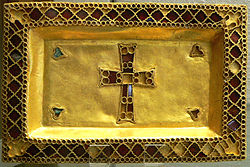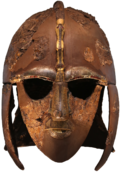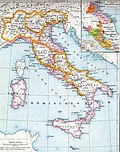Early Middle Ages
The Early Middle Ages were a period in European history that lasted from the 5th century to the 10th century and were followed by the High Middle Ages and the Late Middle Ages. The time is called the “Middle” Ages because it came between ancient history and modern history. The Middle Ages are sometimes called the Medieval Age.
The early Middle Ages has also been called “the Dark Ages” because scholars in early modern times could not find much information about that time. They thought that there was very little culture, good literature, art, good architecture, technology or progress during this period.
Fall of Rome
The Early Middle Ages started with the fall of the Western Roman Empire, which had ruled much of Europe in ancient history.
Eventually, the empire started to weaken. In 410, Rome was sacked by Alaric, the leader of the Germanic tribe known as the Visigoths. Rome survived but had been greatly weakened. In 476, when Rome was again invaded and sacked by Odoacer, he took the city for himself. He made himself the king of Italy. This ended the Western Roman Empire. Europe entered the Early Middle Ages.
Life in the Early Middle Ages
As the Early Middle Ages began, Europe was experiencing the effects of the fall of the Western Roman Empire. Before, the empire’s communication systems made it possible for people all over Europe to share ideas and facts. Now these communication systems were no longer working. This made it much more difficult to exchange knowledge and new ideas.
For many years, the Roman army had defended the empire and kept peace between different parts of Europe. Now, wars became common as people all over Europe started to fight each other for territory and resources.
The Catholic Church was very powerful during the Early Middle Ages. Most Europeans were Christian at this time.
Early Middle Ages Media
The jewelled cover of the Codex Aureus of St. Emmeram, c. 870, a Carolingian Gospel book
Replica of the Sutton Hoo helmet; the original was buried with an Anglo-Saxon leader, probably King Rædwald of East Anglia, c. 620–625 CE.
A paten from the Treasure of Gourdon, found at Gourdon, Saône-et-Loire, France.
Restored Walls of Constantinople
Christ crowning Constantine VIIivory plaque, ca. 945
The Sutton Hoo helmet, an Anglo-Saxon helmet from the early 7th century
The Gokstad ship, a 9th-century Viking longship, excavated in 1882. Viking Ship Museum, Oslo, Norway









